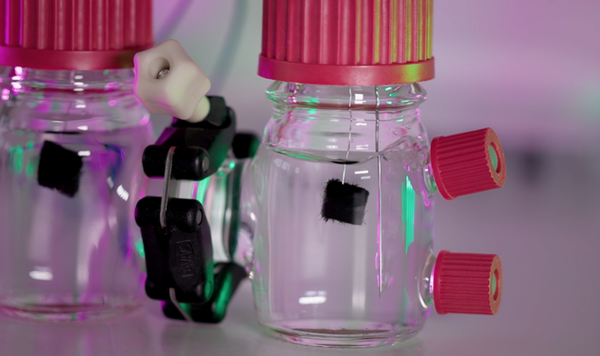[스위스] EPFL 부품, 부품공학 대장균 헌터로 폐수에서 전기 생산

폐수에서 전기를 생산하는 대장균군 [사진출처(사진출처)=EPFL]
로잔 공과대학(Ecole Polytechnique Federale de Lausanne, EPFL) 소속들은 대장균(E.coli) 구성원을 괴롭히해 폐수(폐수)에서 전기를 생산했다고 했습니다.
아르데미스 보고시안(Ardemis Boghossian) EPFL의 교수는 "자연적으로 전기를 생산하는 외래 개체가 존재하지만 특정 화학 물질이 있을 수 있는 전기를 생산할 수 있다"고 "반면, 대장균은 폐수를 포함한 다양한 환경에서 전기를 생산할 수 있다”라고 말했습니다.
줄(Joule) 저널에 실린 협회에서 보고시 팀은 대장균의 전력 생산 능력을 발휘하여 전자 공학의 성과를 보고했습니다.
대장균은 구성을 쉽게 조작할 수 있어서 오랫동안 조사원들이 선호했습니다.
대장균 박테리아는 ‘세포외 전자전달(Extracellular electron transfer, EET)’ 과정을 통해 전기를 생산한다. EPFL 연구원들은 대장균 박테리아가 향상된 EET 능력을 보이도록 조작했고, 박테리아를 매우 효율적인 “전기 미생물”로 만들었다.
이번 연구의 주요 혁신 중 하나는 대장균 내에 완전한 ‘EET 경로’를 만드는 것이다.
전기를 생산하는 것으로 유명한 박테리아인 민물 퇴적층 박테리아(Shewanella oneidensis MR-1)의 구성 요소를 통합함으로써, 연구자들은 세포의 내부 및 외부 막에 걸쳐 있는 최적화된 경로를 성공적으로 구축했다.
이 새로운 경로는 기존에 비해 전류 발생량을 3배 증가시켰다.
중요한 것은 조작된 대장균이 양조장에서 수집한 폐수를 포함한 다양한 환경에서 뛰어난 성능을 보였다는 것이다. 생체공학 전기 대장균은 다양한 환경에서 유기 기질을 대사하면서 전기를 생산했다.
이는 유기 폐기물 처리와 동시에 전기를 생산하는 혁신적인 솔루션을 의미한다.
보고시안의 연구팀은 로잔에 있는 지역 양조장인 레 브라쇠르(Les Brasseurs)에서 수집한 폐수에 기술을 실험했다.
생체공학 대장균은 양조장에서 수집한 폐수를 먹어 치움으로써 기하급수적으로 번성하는 반면, 외래 전기 미생물은 생존조차 하지 못했다.
생체 전기 미생물은 점점 더 많은 실제 응용 분야에서 사용되고 있다.
다양한 출처로부터 전기를 생산할 수 있는 능력이 있는 생체공학 대장균은 미생물 연료 전지, 전기 합성, 그리고 바이오 감지 등에 활용될 수 있다.
또한, 박테리아의 유전적 유연성은 그것이 특정 환경과 사료에 적응하도록 조정될 수 있다는 것을 의미하며 지속가능한 기술 개발을 위한 도구로써의 가능성을 의미한다.
한편, 생체공학 대장균의 성능을 최적화하고 실제 적용을 위해 기술을 확장하려면 추가적인 연구 개발이 필요할 것으로 보인다.
[원문보기]
Bacteria generate electricity from wastewater
In a breakthrough for the field of bioelectronics, researchers at EPFL have enhanced the ability of E. coli bacteria to generate electricity. The innovative approach offers a sustainable solution for organic waste processing while outperforming previous state-of-the-art technologies, opening new horizons for versatile microbial electricity production.
“We engineered E. coli bacteria, the most widely studied microbe, to generate electricity,” says Professor Ardemis Boghossian at EPFL. “Though there are exotic microbes that naturally produce electricity, they can only do so in the presence of specific chemicals. E. coli can grow on a wide range of sources, which allowed us to produce electricity in a wide range of environments, including from wastewater.”
In a paper published in the journal Joule, Boghossian’s team report a groundbreaking achievement in bioelectronics, advancing the capabilities of common E. coli bacteria to generate electricity. The work outlines a novel approach that could revolutionize both waste management and energy production.
E. coli bacteria, a staple of biological research, have been harnessed to create electricity through a process known as extracellular electron transfer (EET). The EPFL researchers engineered E. coli bacteria to exhibit enhanced EET, making them highly efficient “electric microbes.” Unlike previous methods that required specific chemicals for electricity generation, the bioengineered E. coli can produce electricity while metabolizing a variety of organic substrates.
One of the study’s key innovations is the creation of a complete EET pathway within E. coli, a feat not achieved before. By integrating components from Shewanella oneidensis MR-1, a bacterium famous for generating electricity, the researchers successfully constructed an optimized pathway that spans the inner and outer membranes of the cell. This novel pathway surpassed previous partial approaches, and led to a three-fold increase in electrical current generation compared to conventional strategies.
Wastewater as a playground
Importantly, the engineered E. coli exhibited remarkable performance in various environments, including wastewater collected from a brewery. While exotic electric microbes faltered, the modified E. coli thrived, showcasing its potential for large-scale waste treatment and energy production.
“Instead of putting energy into the system to process organic waste, we are producing electricity while processing organic waste at the same time – hitting two birds with one stone!” says Boghossian. “We even tested our technology directly on wastewater that we collected from Les Brasseurs, a local brewery in Lausanne. The exotic electric microbes weren't even able to survive, whereas our bioengineered electric bacteria were able to flourish exponentially by feeding off this waste.”
The implications of the study extend beyond waste treatment. Being abile to generate electricity from a wide range of sources, the engineered E. coli can be utilized in microbial fuel cells, electrosynthesis, and biosensing – to name a few applications. In addition, the bacterium’s genetic flexibility means that it can be tailored to adapt to specific environments and feedstocks, making it a versatile tool for sustainable technology development.
이번 연구의 주요 저자인 Mohammed Mouhib는 “조작된 생체 전기 미생물이 점점 더 실제 응용 분야에서 한계를 뛰어넘고 있기 때문에 우리의 연구는 매우 시의적절합니다.”라고 말했습니다. “부분적인 경로에만 의존했던 기존의 최첨단 기술과 최근 이 분야에 발표된 가장 큰 논문 중 하나에 사용된 미생물과 비교하면 새로운 기록을 세웠습니다. 현재 이 분야의 모든 연구 노력을 통해 우리는 생체전기 박테리아의 미래에 대해 기대하고 있으며 우리와 다른 사람들이 이 기술을 새로운 규모로 추진하기를 기대하고 있습니다.”
[출처 = EPFL ( https://actu.epfl.ch/news/bacteria-generate-electricity-from-wastewater/ ) / 2023년 9월 11일]










































